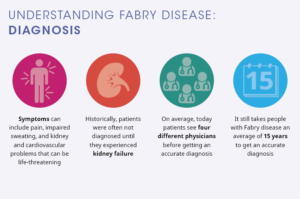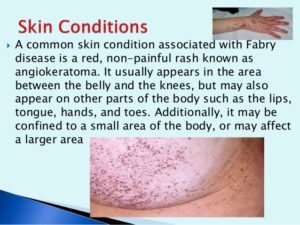Fabry disease is a rare genetic disorder caused by a defective gene (the GLA gene) in the body. In most cases, the defect in the gene causes a deficient quantity of the enzyme alpha-galactosidase A. This enzyme is necessary for the daily breakdown (metabolism) of a lipid (fatty substance) in the body called globotriaosylceramide abbreviated GL-3 or GB-3. When proper metabolism of this lipid and other similar lipids does not occur, GL-3 accumulates in the majority of cells throughout the body. The resulting progressive lipid accumulation leads to cell damage. The cell damage causes a wide range of mild to severe symptoms including potentially life-threatening consequences such as kidney failure, heart attacks and strokes often at a relatively early age. Fabry disease is a progressive, destructive and potentially life-threatening disease. Fabry disease can affect males and females of all ethnic and cultural backgrounds.
Pain is one of the more common symptoms of Fabry disease, and is often one of the first symptoms people experience. There are two major types of pain associated with Fabry disease:
- Ongoing burning, tingling pain, and discomfort. This type of pain is called acroparesthesia, and mainly affects the hands and feet.
- Occasional episodes of intense, burning pain. These usually start in the hands and feet, and can often spread to other parts of the body. These are called “Fabry crises”, and can be debilitating. Fabry crises may last anywhere from minutes to several days.
Pain – This pain can also be brought on by changes in weather, exposure to hot temperatures, stress, exercise, and/or fatigue.
Fatigue – Although the causes of fatigue in Fabry disease are not well understood, it is a common symptom of the disease. People with Fabry disease may need to manage their activity level and take frequent breaks.
Perspiring – Many people with Fabry disease either perspire very little (hypohidrosis) or not at all (anhidrosis). This can cause overheating, frequent fevers, and sensitivity to extremes in temperature. Impaired sweating is generally caused by damage to the nerves and sweat glands.
Exhaution – Some people with Fabry disease are unable to tolerate physical exertion, and may tire or become overheated even after mild activity. Physical exertion may also trigger episodes of pain. For these reasons, people with Fabry disease may need to modify their physical activities and/or avoid certain activities altogether.
Dark Red Skin Rashes – One of the most visible signs of Fabry disease is a reddish-purplish rash called angiokeratoma. This rash is characteristic of the disease, and may lead doctors to suspect Fabry disease. Angiokeratomas are generally located between the navel and the knees (doctors call this “bathing trunk distribution”), and sometimes in areas where the skin stretches, such as elbows or knees. Angiokeratomas usually appear during adolescence, and can become larger and more numerous with age.
Corneal whorling – This is another symptom. A starburst pattern on the cornea caused by GL-3 accumulation in the blood vessels of the eye. Corneal whorling can only be seen through a slit-lamp ophthalmoscopy exam. It typically does not affect vision.
Stomach problems – This can range from mild to severe. These disturbances may include pain after eating a meal, diarrhea, vomiting and nausea.
Heart Problems – As GL-3 accumulates over many years, progressive damage can occur to the tissues of the heart, as well as to those blood vessels that supply the heart. Heart problems due to Fabry disease may include:
- Enlarged heart (cardiac hypertrophy)
- Malfunctioning heart valves
- Irregular heartbeat
- Heart attack
- Heart failure
Kidney Problems – After years of GL-3 build-up, problems with the kidneys can develop, and kidney function may become compromised. Kidney damage can become so severe that the kidneys do not function properly (renal insufficiency) or may fail (renal failure). Thus, GL-3 accumulation in the kidneys represents a major health risk for those with Fabry disease, and may be present in the absence of kidney disease symptoms. However, kidney problems are not unique to Fabry disease. Often, it is other signs and symptoms (like pain and angiokeratomas) that may lead a doctor to suspect Fabry disease.
Nervous system problems – Significant GL-3 accumulation can thicken small blood vessels in the brain. As a result, people may experience a number of symptoms including:
- Weakness
- Head pain
- Numbness
- Dizziness
- Stroke
Hearing Problems – Hearing loss and tinnitus (ringing in the ears) may develop in adulthood.
Psychosocial problems – Often the difficult physical symptoms are only one of the challenges that people living with Fabry disease may face. They may also experience fear, depression, isolation, or guilt about passing the disease along.


